Mike Cole Blog by Joe Jackson
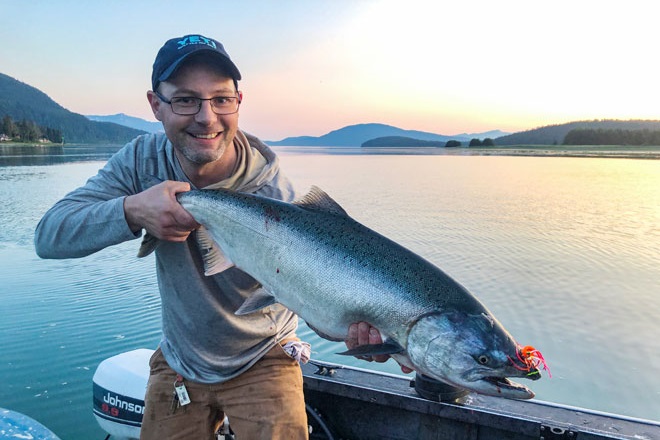
Yet another king that fell for Mike Cole and Mr. Bodangles’s tricks.
Doing Something with Your Life
Mike Cole didn’t get home from his senior year prom until 4 a.m.
Two hours after that, he’d already swapped his tuxedo for a pair of waders and was sloshing up a dark and lonely creek somewhere on Admiralty Island. Dawn broke through gauzy fog, and once Cole and his friends spaced themselves out and began making casts, things became quiet and focused. Their quarry was the fish of legends; the species that Cole had seen on a television program almost a decade earlier, and one he credits with beginning the illness which continues to afflict him today.
Somewhere in the mist, Cole hooks a fish. Electricity surges through the line, then the rod, then his hands, which only hours before had been swinging his date around the dance floor. A vein of silver launches from the water like a warhead—Cole is shouting for his friends—the line rips upstream—no one comes—his heart is kicking against the inside of his chest as he draws the fish closer, close enough to see the black egg-sucking leech pinned in its jaw.
It’s a week or so later. The creek where he caught his first steelhead is without doubt the first place Cole wants to be, but at that moment he’s in perhaps the last: the school counselor’s office.
“It doesn’t look like you’ve applied to any colleges,” the counselor says, slightly worried as he sifts through Mike Cole’s transcript.
Cole nods to confirm. He can still feel his first steelhead in his hands and see the shimmer of chromium as it shoots back home. Compared with chasing fish like that, going off to college, along with pretty much everything else, seems pretty dull.
“I’ve gotta ask you then, Mike…” The counselor sets the transcript down and drills his gaze into the wayward eighteen-year-old. “What is it you wanna do with your life?”
Ever since he’d started flyfishing, Mike Cole had wanted to be a fishing guide. He could think of nothing more enjoyable or rewarding than spending the days doing the very thing he was growing to love, along with passing that passion on to other people. As the old saying goes, and is likely proclaimed by every parent in existence by now: “If you love what you do, you’ll never work a day in your life.”
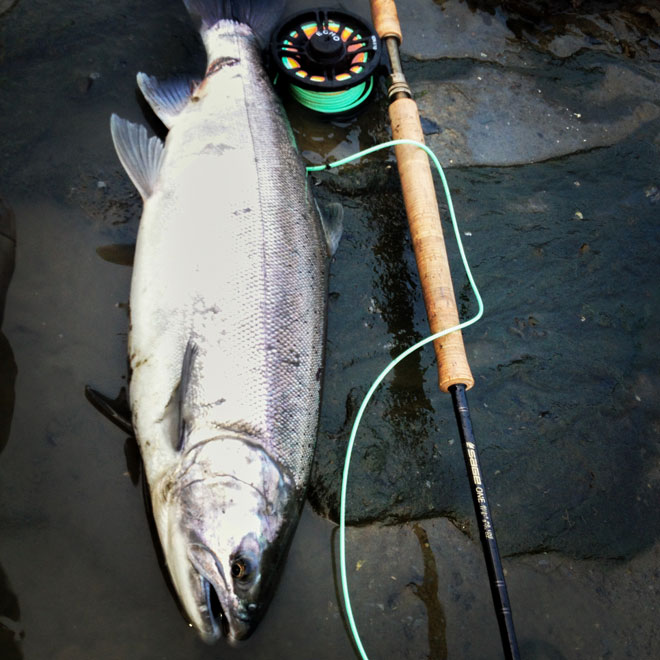
A common (but still addicting) sight for Mike Cole: chrome.
Cole’s chance to enter the industry came along serendipitously, as these things often do. Throughout high school he had been a ski instructor, which led to connections in the whitewater rafting world, which led to a phone call from Brad Elfers (owner of Alaska Flyfishing Goods) about a new fishing guide outfit based out of Juneau. Called Bear Creek Outfitters, the new job gave Cole the chance to get his feet wet in the guiding industry. It also served to cement him within the then-dogmas of flyfishing (in other words: full-fledged snobbery). By yet another lucky happenstance, Cole visited South America and secured a job as a guide in southern Chile not long after. Here, he not only got the chance to fish during Alaskan winters, but he realized that flyfishing could be and was done far differently at the bottom of the world than at the top. Instead of the typical Glo-Bug nymphing setup Cole was used to on Alaskan salmon streams, he was fishing fat dry flies. In scenarios where he would normally strip small streamers, the Chileans would use heavily-weighted flies on dense sink-tip lines. After seven years of traveling between hemispheres, Cole’s viewpoint had opened up; though not nearly to the extent that it would when he came to start fishing conventional tackle again.
By 2003, Cole had landed a gig at a flyout lodge in Bristol Bay. Initially, he signed up to spend king salmon season out there; but as it would turn out, he didn’t come home until September. Every week he’d get a call asking if he was ready to come home yet, and every week he’d reply with an unequivocal “no” because the fishing had only continued to improve. Mike Cole cites this period of his life as the most influential to his growth as a fly tyer; not because the fishing was so good or because he did so much of it, but because he was using both fly and conventional gear.
Just a few years prior, using a spinner would’ve been a cardinal sin to Cole. Between 2003 and 2007, however, it was the name of the game for many clients. Rather than fight or curse the effectiveness of conventional tackle, Cole decided to try and emulate some of its merits: namely, vertical movement through the water column. He’d come to realize that perhaps one or two cohos in a group would follow a streamer, but that entire schools would be agreeable to chasing a jig. He began whipping up prototypes and systematically testing them, though he wasn’t struck with an epiphanous bolt of lightning until later.
Cole got married and settled down in Juneau by 2008, where he also went back to work for Brad Elfers at Alaska Flyfishing Goods (AFFG). AFFG’s online presence was growing across the state by that time, and in addition to bringing intimate knowledge about Bristol Bay to the table, Mike Cole became the shop’s web developer. It was a perfect opportunity to revamp his development of a coho fly, which would need to achieve the steep jigging action that he’d discovered was so critical in Bristol Bay, while also being supremely castable and durable with the majority of Juneau’s fishing being from beaches.
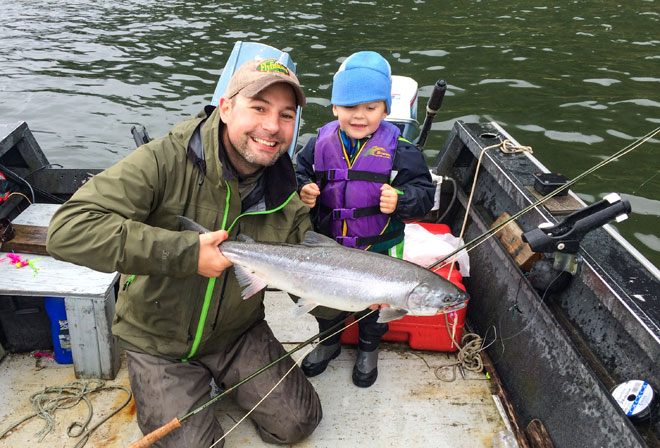
Mike Cole and his son, Oliver, with Oliver’s first fish.
By then, of course, the Dolly Llama was well-known, and in fact was being used to great effect for Juneau silvers when tied in bright colors. Cole continued to seek something more castable than the soaked bunny strip of a Dolly, however, and was further inspired to create a reflection of the squid jigs used by saltwater fishermen. What he ended up with was a dangly, funky-lookin’ coho fly that would come to both garner enormous fandom in Alaska’s salmon fishing community, as well as set Cole himself up for continued fly innovation: the Mr. Bodangles.
Bill “Bojangles” Robinson was the highest-paid black entertainer of the early 20th Century. He was a singer, actor, and, perhaps most notably, he taught Shirley Temple how to tap dance, (in fact he was the first black performer to appear in a Hollywood interracial dance group in the Temple film The Little Colonel in 1935). Bojangles’s signature performance became known as the “stair dance,” an elaborate tap routine which showcased uncanny skill, precision, and a free-flowing movement of limbs that I can only think to describe as “squiddy.” After some deliberation, Cole decided to call his fly the Mr. Bodangles as both a homage to Bill Robinson and a perfect descriptor of the fly itself, which featured a collar of dangling rubber legs. He and Brad sent the fly off for production thinking it would be a hot-ticket item come fall, but no sooner had they done that when an angler came in asking about king flies. Cole gave him a Mr. Bodangles to try out; a day passed, and the angler was back asking for more, and tied in bigger sizes.
Just a year later, Cole got the chance to originate another gem: the Liquid Wrench. His adventures for steelhead in southeast Alaska involved swinging the typical egg-sucking leeches or dead-drifting Glo-Bugs, but Cole’s favorite pattern was a creation of Umpqua’s called the Laser Fly. While he felt the hook gap was too small, the fly itself was deadly. Fast-forward to Bristol Bay, where Mike met a variety of seasonal guides from Washington and Oregon. Most of these anglers swore by jigs drifted under an indicator; in their hard-fished rivers of the Pacific Northwest, there was nothing better. By 2009, when Brad asked him to develop a steelhead fly for the shop, Cole had a pretty good idea of what he wanted to achieve. He’d need a fly that got down fast, had the optimal amount of flash to attract but not discourage, and combined a jig-style hook with a loose dubbing ball to maximize underwater movement.
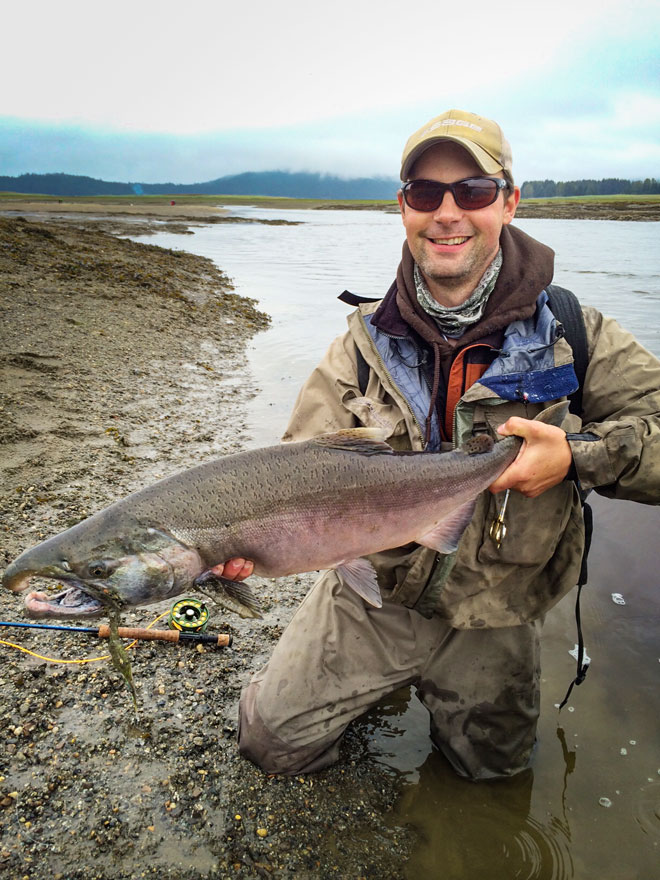
Cole with an absolute stud of a coho from a Juneau-area tidal zone.
Brad Elfers gets the credit for naming the resulting pattern. When faced with difficult steelhead, either rusted up with lockjaw or tucked underneath impossible logjams, he’d announce that he needed to “spray some liquid wrench on there!” And he’d proceed to catch fish. The name stuck, and today the Wrench has become one of Alaska’s favorite steelhead flies.
Cole also tells me about some articulated sculpin patterns that he is currently working on. Their journey began during his guiding days in Bristol Bay, and while they are effective, they never really caught on. He hopes to change that.
Cole’s genius isn’t limited to original creations. He’s adapted a variety of beloved patterns for sale in the fly shop, either to make them more user-friendly or species-specific. Take the Dolly Llama, for example. The fly is great, but for use on smaller streams with smaller-weight rods, the original is like casting a dumbbell. Cole tweaked the pattern to include a downsized hook that was easier on trout mouths, a smaller, tungsten conehead, and he adjusted the thickness of the rabbit strips to achieve a lighter payload (and one conquerable on a five-weight). Conversely, he upscaled the original to make it a worthy target of king salmon.
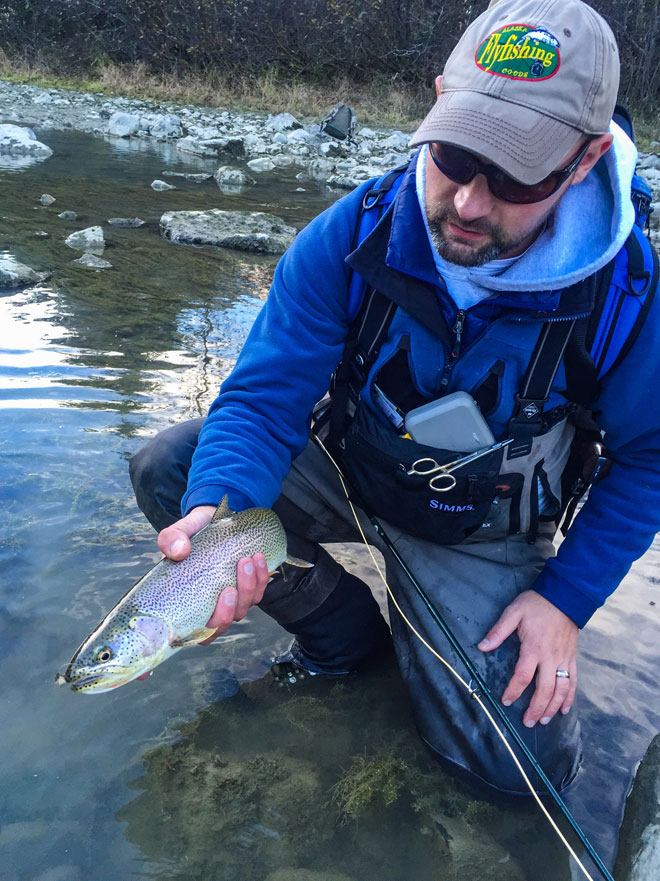
Cole with an awesome coastal cutt taken on the trusty Elk-Hair Caddis.
He’s also made cosmetic changes to Joe Howell’s Starlite Leech. Originally, the pattern was tied with standard chenille, cactus chenille, and rabbit, but Cole noticed that one version featured polar chenille and was somehow doubly effective. After that version fell out of production or was otherwise lost to obscurity, Cole decided to revitalize the fly and dub it the UV Polar Starlite Leech. This variant is one of AFFG’s hottest sellers. He undertook a similar resurrection with the Veiled Assassin, a pattern developed in Oregon by Michael Gorman, but which was discontinued by Umpqua. Cole’s spin featured the addition of a beadhead.
Harkening back to his days in Bristol Bay, Cole also devoted some time to a fly that some other guides had developed: the STS Leech. This marabou-and-bunny string leech was a stand-by out there, but Cole adjusted the dubbed head, hourglass eyes, and added a dubbed butt. He attests that the Midnight Crusher color combo is especially effective.
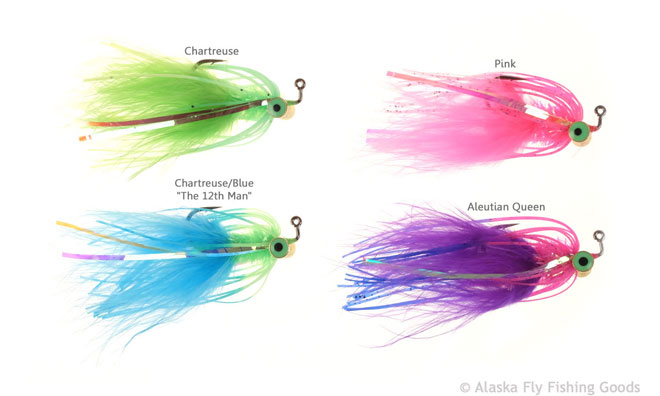
Mr. Bodangles in the flesh, available in multiple colors and sizes. (Photo courtesy of Alaska Flyfishing Goods)
Last but not least, Cole’s work on the Sockeye Lightning fly cannot be ignored. He developed a version of the fly for use in Bristol Bay, only to find out that several other anglers had come up with similar patterns independently. Once he returned to Juneau and AFFG, Cole worked to hone the pattern for Southeast streams. On a river like the Kenai, of course, sockeyes are moving steadily through the system (which is why flossing is so popular and, generally, critical). On many Southeast streams, however (the Situk, say, or Windfall Creek near Juneau), the sockeyes spend much more time in staging pools. After the release of the Lightning, the pattern was met by critical acclaim and stories of sockeyes moving several feet out of their position to make chase.
But that’s not unheard of for a Mike Cole fly.
At about the time Cole finally settled down in Juneau, and just before the Mr. Bodangles would take off in 2008, he happened to run into an old friend at a bar in Juneau. After some of the pleasantries about work and family, the friend had to ask:
“So what did you end up doing with your life?”
Of course, there wasn’t enough time to tell it all, but Cole might’ve tried. He would’ve told stories of fishing in Patagonia, where the Andes rose like fortresses all around and where the water was emerald-blue. The trout there eat beetles the size of your thumb. He would’ve recounted the pleasantly endless days of Bristol Bay in summer, during the height of salmon and trout season when he’d watch clients battle fish all day and have the time of their lives, then he’d retire either to the tying vice or straight back to the river to catch a fish of his own. Rivers like the Togiak and the Goodnews have held his heart since he met them. By the time the beer was running low and the hour was growing late, Cole would’ve declared that working as a fishing guide and then going to work in a fly shop was the most rewarding profession he could imagine. He’d spent all that time learning how to fish, and more importantly why to fish, and now he was receiving the dividends of passing that on to others. He might’ve—and this is total conjecture—but he might’ve even talked about a dangly little coho fly that he was working on at home.
Soon he and the friend parted ways, off into the darkening mist of southeast Alaska. Cole would’ve recalled a certain day, not that long ago, when he was sitting in an office reeling in the memories of his first steelhead.
The friend had been his high school counselor.
Joe Jackson is a fly nerd who wishes to thank each and every subject of “Behind the Vice” for indulging his curiosity. Joe has written for Fish Alaska, The Flyfish Journal, The Drake, and American Flyfishing, and his favorite fly to tie is a toss-up between the Splitsville Caddis and the classic Hare’s Ear.
